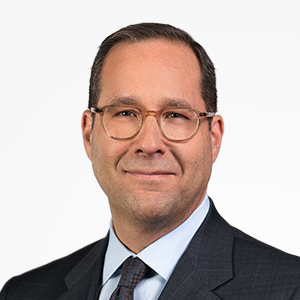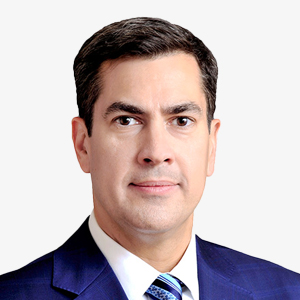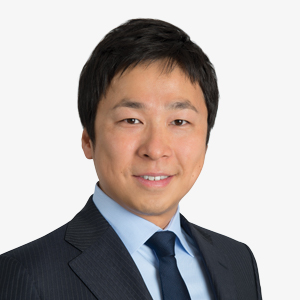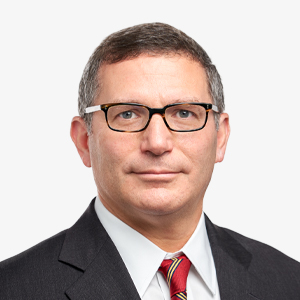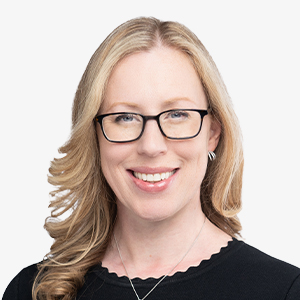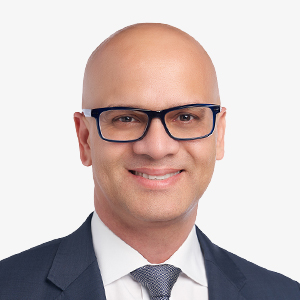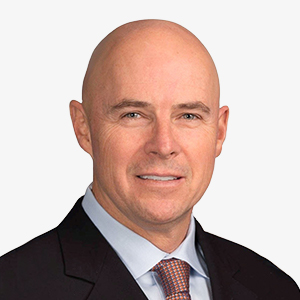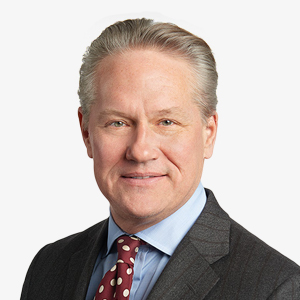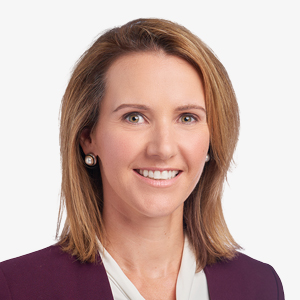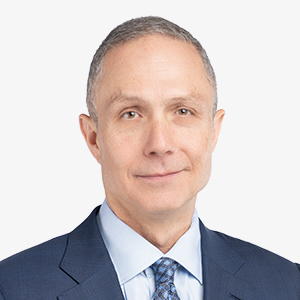Asset Allocation Committee Outlook
—Erik L. Knutzen, CFA, CAIA, Chief Investment Officer—Multi-Asset
—Niall O'Sullivan, Chief Investment Officer, Multi Asset Strategies – EMEA
Many investors remain overweight cash, but markets have begun to price for a substantial decline in short-term interest rates. The Asset Allocation Committee (“the AAC”) therefore thinks it is time to deploy liquidity, locking in bond yields before they, too, are dragged down, and seeking out value in equities and other markets. As a result, we have heavily downgraded our view on cash. However, while a redeployment of cash and declining rates could sustain current market momentum, rates are priced for a decline because economic growth is expected to slow, and that fragile fundamental backdrop makes us cautious where valuations are full. Instead, we favor the laggards of the past 12 months, which we think could benefit not only from liquidity coming in from the sidelines, but also from our central scenario of gradually declining inflation and slowing but not recessionary U.S. growth. That includes large swaths of the fixed income universe, especially short to intermediate maturities where yields still reflect today’s high policy rates. It also includes those pockets of the equity market that have priced for a harder landing or appear structurally undervalued, such as small caps, industrial, real estate and healthcare sectors, value stocks and Japan. Commodities, especially industrial metals, have also priced for a harder landing, and could be a useful hedge against unexpected upside in inflation or growth—particularly should that originate in China. When cash begins to drag on returns but economic fundamentals remain uncertain, conservative valuations become an investor’s friend.
According to the fund-flows data provider EPFR, almost $1.2tn flowed into U.S. money market funds in the first 11 months of 2023. At almost $6tn, those fund assets are at an all-time high.
A growing perception that interest rates have peaked and may even be cut in the first quarter of 2024 could start to reverse those flows. Investors who see the market pricing for a rapid decline in cash rates and appreciate the potential for non-cash assets to benefit may already be putting their liquidity to work.
In fixed income, the case for doing so is clear, in our view—even when considering short- to intermediate-duration government bonds.
Today’s U.S. dollar cash rate is still more than a percentage point higher than the U.S. two-year Treasury yield to maturity, and 1.5 percentage points higher than the bond’s current or “running” yield. But forward-rate pricing, particularly following the U.S. Federal Reserve’s (Fed) December meeting, suggests this is unlikely to last.
Fed Chair Jerome Powell has said that further hikes are not expected, and of the 19 policy-setters, only eight now see inflation risks biased to the upside, down from 14 at the previous meeting. The median outlook from the Fed’s new “dot plot” suggests there could be 75 basis points of cuts during 2024, up from 50 basis points in the previous plot. That is not as aggressive as the path priced into forward rates, as several central bank officials have pointed out, but the direction of travel is becoming clearer.
If we assume those forward rates come to pass, and that the two-year bond yield rolls down steadily to the projected cash rate in two years’ time, the estimated total return from rolling the cash position would be only slightly higher than the income gained from reinvesting the bond coupons. Add in the capital appreciation from the bond rolling down a steepening curve, and the estimated total return of the bond equals that of cash.
In our view, it is time to start locking in yield.

Why are rates projected to decline? Because inflation and growth are also expected to decline. Against that background, we continue to favor government and investment-grade corporate bonds. We also take a positive view on securitized products, especially mortgage-backed securities, where high quality is currently paired with attractive value due to a supply-and-demand mismatch through 2022 and 2023.
Shorter-duration, high-quality, high yield bonds could also be attractive for those seeking more potential return. Leverage is low and interest coverage is high, in general, and recent months have seen the worrisome maturity wall pushed out quite substantially: according to JPMorgan data, 2024 and 2025 maturities in the U.S. market have declined by some 40% since April and 2024 maturities are down almost 80% in the European high yield market. Overall, however, we remain neutral on high yield given relatively tight spreads, the still unfolding impact of higher rates and the potential for slower growth.
Ultimately, our fixed income views are largely unchanged since last quarter, with one big exception: the value we saw for cash as part of our favorable view on shorter duration bonds is no longer there.
The AAC’s outlook for equities is more complex. Here investors face an “optionality” consideration rather than a simple question of the relative value of short-term income streams. Is now an opportune time to deploy cash into the equity market, or might valuations get cheaper?

Declining inflation, growth and rates could boost valuations, but U.S. large-cap multiples in particular are already quite high. Moreover, they are high even on ambitious earnings growth projections for the coming year. Analysts are currently forecasting 2024 S&P 500 Index earnings at $244 per share, which would be a rise of around 12% on 2023. For comparison, earnings grew by less than 2% in 2023, while GDP growth was constantly surprising on the upside. In Europe, where we see a more challenging economic growth outlook, analysts are similarly forecasting 6% earnings growth this year after a decline of 1.2% in 2023.
Nonetheless, one of the lessons of 2023 is that markets can defy apparently soft fundamentals for much longer than expected. Furthermore, the recent rally has brought us back only to the price levels equities reached two years ago, with some way to go to re-test highs for valuation in most categories. Index valuations also appear less full once mega-cap technology stocks are stripped out. Finally, last year’s recovery got going with rates rising rapidly and investors rushing into cash—we think it is rash to assume the recovery will fizzle out while rates are declining and a huge pile of cash is potentially coming off the sidelines.
When the market is subject to a tide of liquidity, sentiment and momentum, that tide is likely to lift all boats. A lot of potential return can be left on the table if investors make meaningful bets against “overvalued” stocks, sectors, regions or styles. For that reason, the AAC retained its neutral view on most of the headline equity categories.
That said, as the illustration above suggests, some valuations rebounded less than others during 2023. Those relatively lower valuations could provide a buffer against downside growth surprises and especially upside inflation surprises next year. They may also attract a meaningful share of flows from cash or from a rotation out of mega-cap tech, if investors are concerned about stretched valuations and seek out last year’s laggards.
The outstanding example, in our eyes, is U.S. smaller-company stocks. The Russell 1000 Index of U.S. large-caps finished 2023 up 24% on a valuation multiple of 22 times earnings, while the Russell 2000 Index of small-caps was up 16% on a multiple of 14 times. Some of that gap could close this year, potentially quite rapidly. Smaller companies are also likely to find greater relief in easier financing conditions.
The value style is another area that has not fully participated in the upswing of recent months. The Russell 1000 Growth Index outperformed the Value Index last year by 41% to 12%. Their multiples are 33 and 16 times, respectively. Lagging sectors include financials, industrials, materials and healthcare.
Regionally, we think the picture is more ambiguous.
European equities appear relatively cheap, but Europe’s economy is already weaker than that of the U.S. and appears to be weakening still further. A growth surprise out of China would help, as it did at the beginning of 2023, but that is not our central scenario. A weaker U.S. dollar would also help, but that is not in our immediate outlook, either (see “Up for Debate: Are We Dollar Bulls or Bears?”).
The AAC continues to prefer Japan, which benefits from a number of tailwinds: attractive valuations (even after some recent catch-up); a long-awaited return to positive growth and inflation; Japanese investors’ growing appetite for domestic exposure; the strong dollar and weak yen; and a structural turn to more shareholder-friendly governance and management. Perhaps the biggest risk to Japanese equities in the first half of 2024 is the overwhelmingly positive buy-side and sell-side consensus in favor of the market.
On emerging markets, the AAC comes out neutral as it balances a cautious view on China, which dominates the category, against a more favorable view on other markets, such as India, where strong growth should continue to provide a tailwind.
In private markets, we believe our longstanding major theme of seeking out liquidity and capital shortages has some way to run. Whereas abundant flows have been and could continue pushing public-market valuations up, a lack of flows from over-allocated investors in private markets is resulting in some attractively valued opportunities.
General Partner-led secondaries, as well as the emerging category of mid-life co-investments, offer to provide liquidity in exchange for often-discounted exposure to high-quality assets. Capital solutions, which can help sponsors of private companies bridge the gap between equity and debt when they have opportunities to grow but are unable to borrow and unwilling to dilute shareholders, can realize attractive returns with lower leverage. Consumer lending, residential mortgage lending and receivables financing can step in and earn attractive rates where banks remain tentative. These approaches account for much of the AAC’s decision to maintain their overweight views in private markets. The capital-shortage theme is no longer as strong in senior lending to private equity-sponsored companies, where the broadly syndicated loan market is starting make a comeback, but the AAC remains positive given high yields, declining leverage and ample deal flow.
The theme of seeking out capital shortages also crosses over into the AAC’s views on liquid alternatives. It is why insurance-linked strategies, such as catastrophe bonds, are one of the few genuinely bright spots in the category: a shortage of capital in the property-and-casualty insurance sector is leading to an abundance of risk transfer at attractive prices.
The other area where the AAC takes a favorable view—somewhat at odds with the bearishness of the market heading into an expected economic slowdown—is commodities. Commodities in the energy and especially the industrial metal sectors, which have been sensitive to the slowdown in China and global manufacturing, are priced for a hard landing, even as large parts of the equity and bond market are priced for a near-immaculate disinflation. We do not anticipate meaningful growth in supply through 2024, but we could see some restocking of inventories as the manufacturing recession eases and rates decline; that has the potential to push up prices, as well as the roll yield from the futures curve.

Furthermore, in our view, commodities are the perfect hedge against the biggest risks to our central economic scenario: an unexpected spike in inflation or an upside growth surprise, particularly if it originates from China, and any further additions to the long list of recent political and geopolitical shocks.
As we head into a record-breaking year of elections worldwide, with Taiwan at the outset and the U.S. Presidential election in November, we believe this exposure could prove a valuable source of diversification.
A number of the AAC’s views hinge upon the outlook for the U.S. dollar—particularly our views on regional equity allocations.
The dollar raced to its recent peak at the end of 2022 as the Fed marched ahead of the other major central banks with its rate hikes. It then declined steadily as markets began to price for the terminal rate. A rally through July, August and September last year, driven by a widening growth gap with the rest of the developed world, has been reversing. Market positioning has started to become quite bearish.
We understand that sentiment—and some members of the AAC share it. The dollar remains expensive, according to purchasing power parity (PPP) metrics. Some signals from the Fed that have been more dovish than those from the European Central Bank (ECB), especially since their December meetings, have pushed the dollar lower.
The majority on the Committee believe that the dollar is likely to stay in the trading range that has been developing through 2023, however, at least for the first quarter of this year.
While PPP metrics make the currency look expensive, it looks more reasonably valued based on interest-rate differentials; so far, setting aside the yen, these differentials have not moved significantly because the market has been repricing expectations for other central banks alongside the Fed. U.S. economic data continues to surprise to the upside while data out of Europe and China have been disappointing. The majority of AAC members believe we need to see not only a fundamental weakening in the U.S. jobs market to push the dollar through the bottom of its trading range, but also some signs of recovery from Europe and/or China.
Those conditions may materialize, but they may not—and either way, we do not think they are likely early in 2024, leaving us neutral to positive on the dollar over the near term.

While it has been a volatile few years for equity and bond markets, real estate investors have experienced significant ups and downs over this stretch as well. The commercial property sector has arguably been the epicenter for some of the biggest economic disruptions and dislocations of recent times, enduring first the “amazonification” of retail, then the empty offices of the pandemic, and finally the rapid rise in interest rates.
Does the prospect of declining rates signal an opportune time to invest? The AAC believes so, but its overall view remains neutral because the sector exhibits a series of extreme bifurcations.
First, there is the bifurcation between public Real Estate Investment Trusts (REITs) and core private real estate funds. Because the market can express a view on the pricing of REITs, it has: the FTSE EPRA NAREIT U.S. Index fell by 36% between the end of 2021 and October 2023. With the turn in sentiment on interest rates, the REITs market has since staged a substantial rally and may have bottomed out. By contrast, the value of the NCREIF Open End Diversified Core Equity Fund Index (NCREIF ODCE) began to adjust only a year later at the end of 2022, and is currently down just 10.5% from its peak. We suspect there could still be further downward adjustments to private funds’ net asset values.
The second bifurcation is between what our Real Estate Team describes as “the haves and the have-nots”: strong, proven operators with resilient balance sheets in sectors that have strong fundamentals, and those with vulnerable balance sheets stranded in sectors on the wrong side of structural trends. Examples of vulnerable sectors include offices and suburban retail malls, which we see as being on the wrong side of structural remote-working and retail trends, where valuations may struggle to recover. Other sectors are more likely to benefit from those trends, such as single- and multi-family residential, industrial and real estate credit strategies. We also view student housing and self-storage facilities favorably.
Our positive view on real estate credit reflects a broader theme of investing in stakes in real estate General Partners (GPs) themselves, or investing alongside strong operators: in all cases, GPs are seeking out financial and strategic capital, for which they are prepared to pay a premium to keep their businesses growing and ensure they can execute their pipeline of deals. This same theme also informs a positive view on real estate secondaries, where we see attractive discounts being offered by investors seeking liquidity to recycle portfolios, reduce their over-allocations to private markets, or offload assets experiencing temporary distress. All of these views extend our theme of seeking out liquidity and capital shortages in private markets.


- We maintain our overweight view on U.S. TIPS and investment grade corporates, and continue to favor the short and intermediate parts of the yield curve—but no longer cash, which we have downgraded from an overweight to an underweight view.
- We remain cautious on longer-dated bonds on debt sustainability concerns.
- Corporate spreads are now quite tight, and we see the most attractive opportunities in mortgages and securitized credit.
- Hawkishness at the European Central Bank is keeping yields at relatively attractive levels, especially in the two- to seven-year part of the curve, but high economic uncertainty in Europe, caution on Japanese government bonds and longer-dated bonds in general inform against moving to a more positive view.
- Our outlook for credit stresses remains mild and idiosyncratic rather than systemic, and we see a case for shorter-duration, high-quality exposure.
- That said, we think investors buying yield have kept spreads tighter, in many cases, than fundamentals warrant.
- Valuations have become less attractive.
- Within the asset class we favor sovereigns over corporates and Latin America over other regions.


- Both the fundamental outlook and valuations make us cautious, but we think it could be risky to ignore market momentum with the potential for so much investor cash to be deployed as rates come down.
- We favor sectors, styles and regions that lagged during the 2023 recovery, including small and mid caps, which the AAC upgraded from a neutral to an overweight view.
- We see growing signs of a slowdown in Europe, but retain our more favorable view on Japan due to attractive valuations, a structural turn to more shareholder-responsive governance structures and culture, and the Bank of Japan’s gradualist approach to policy normalization.
- A cautious outlook on China is balanced by a more favorable view on other emerging markets, including India, where strong growth should remain a tailwind.


- Some parts of the commodities complex are pricing for an economic hard landing, but we believe demand could revive as the manufacturing slowdown eases, and we do not anticipate meaningful additional supply.
- Commodities can be a useful hedge against inflation spikes, upside growth surprises and geopolitical shocks in 2024.
- We see some opportunity in insurance-linked strategies (where there is a capital shortage) and global macro strategies (which can take advantage of sustained trends), but many other hedged strategies are likely to struggle in a momentum- and liquidity-driven market.
- Private equity remains attractive as policy rates peak and exit activity looks set to pick up. Secondaries and co-investments are attractive as both Limited Partners and General Partners seek liquidity options to increase distributions.
- While signs of a re-opening in the syndicated loan market point to a potential rise in competition for deals over the coming quarters, yields remain attractive, leverage levels are declining and we see ample deal flow.
- Conditions remain volatile, but higher interest rates and uncertainty about the office sector is creating value opportunities for liquidity providers in public REITs and private real estate secondaries, and there may be value to come in primary private markets.
- More structurally, we believe post-pandemic growth dynamics will continue to support key sectors such as data centers, warehouses, industrial, student housing and single- and multi-family residential.
- While the USD has become overvalued based on purchasing power parity (PPP) metrics, it is no longer expensive relative to interest rate differentials. U.S. economic data has surprised to the upside while Europe and China have been disappointing, and the USD tends to benefit from risk aversion and global growth slowdowns.
- The EUR remains undervalued and the European Central Bank remains hawkish in pursuit of its inflation target, but Germany is dragging on Europe’s manufacturing economy, and it is likely we are at the peak of this cycle’s rates.
- The JPY still appears very undervalued, even after the Bank of Japan’s adjustments to yield curve control and the reappearance of inflation. Japan’s growth remains modest and the central bank appears unwilling to act aggressively, but we still think there is more policy adjustment to come.
- Despite being undervalued in terms of PPP and interest rate differentials, and supported by recent economic data coming in better than expected, the concerns are growing over U.K.’s growth prospects, balance of payments and housing market.
- While Switzerland has a positive current account balance and declining global yields could relieve some of the carry-trade pressures from the CHF, the currency is still very overvalued on PPP metrics and global yields remain relatively high.
Joseph V. Amato
Erik L. Knutzen, CFA, CAIA
Ashok Bhatia, CFA
Thanos Bardas, PhD
Joseph V. Amato serves as President of Neuberger Berman Group LLC and Chief Investment Officer of Equities. He is a member of the firm’s Board of Directors and its Audit Committee. His responsibilities also include overseeing the firm’s Fixed Income and hedge fund businesses.
Previously, Joe served as Lehman Brothers’ Global Head of Asset Management and Head of its Neuberger Berman subsidiary, beginning in April 2006. From 1996 through 2006, Joe held senior level positions within Lehman Brothers’ Capital Markets business, serving as Global Head of Equity Research for the majority of that time. Joe joined Lehman Brothers in 1994 as Head of High Yield Research. Prior to joining Lehman Brothers, Joe spent ten years at Kidder Peabody, ultimately as head of High Yield Research.
He received his BS from Georgetown University and is a member of the University’s Board of Directors. He currently serves on the McDonough School of Business Board of Advisors and the Psaros Center for Financial Markets and Policy Board of Advisors. He is Co-Chair of the New York City Board of Advisors of Teach for America, a national non-profit organization focused on public education reform. He is also a Board Member of KIPP NJ, a charter school network based in Newark, NJ, which focuses on educational equity.
Timothy F. Creedon, CFA
Tokufumi Kato, PhD
Hakan Kaya, PhD
David G. Kupperman, PhD
Ugo Lancioni
Shannon L. Saccocia, CFA
Raheel Siddiqui
Robert Surgent
Shannon Saccocia, CFA, is Managing Director and Chief Investment Officer - Wealth for Neuberger Berman. As a member of the firm’s global Asset Allocation Committee, Ms. Saccocia works closely with investment leadership across Neuberger Berman to establish market views, strategic and tactical asset allocation, and portfolio recommendations. She leverages her deep expertise and decades of experience working with individuals, families, financial advisors and small institutions to deliver the firm's comprehensive investment capabilities to Wealth clients. Prior to joining Neuberger Berman in 2023, she was the Chief Investment Officer for five years for SVB Private and Boston Private Wealth, which SVB acquired in July 2021, overseeing portfolio construction, asset allocation, third-party manager selection, equity and fixed income portfolio management, performance and trading. Previously, she held senior roles at Banyan Partners and Silver Bridge Advisors focused on manager selection, asset allocation and portfolio construction.
Shannon received her BA in Economics and History from Brandeis University, and has been awarded both the Chartered Financial Analyst and Certified Investment Management Analyst® designations. Ms. Saccocia is a longtime CNBC contributor and is regularly featured in the financial media. She resides in the Boston area with her husband and two children.
Raheel Siddiqui, Managing Director, Senior Research Analyst, joined the firm in 2004. Raheel is the Senior Investment Strategist in the Neuberger Berman Global Equity Research Department. In this role he researches impending inflection points in the business cycle, risk appetite, inflation, global asset classes, US sectors, style (growth vs. value), and size to enhance fundamental stock selection and portfolio construction processes by taking advantage of emerging trends not fully appreciated by the market. His research spans finding systematic ways of distilling leading or confirming messages from macroeconomic, quantitative, derivatives data, and behavioral data as well as periodically evaluating portfolios for efficient asset allocation.
Prior to this role, Raheel was a part of Lehman Brothers US Equity Strategy Team where he co-authored over 100 strategy reports, many of which were quoted in the Wall Street Journal, Financial Times, and Barron’s. Raheel also worked as a senior member of the Corporate Development team at Monsanto for six years, where he developed industry leading and award winning approach for valuing genomics assets.
Raheel earned MS/BS degrees in Biochemical Engineering from the Indian Institute of Technology and an MBA from Columbia University. Raheel has also been published with the American Institute of Physics.
Accolades referenced are issued by independent third-parties and information regarding specific criteria for accolades is available upon request and generally may be found on such third-party’s website. Barron’s rankings are based on a proprietary formula that considers various factors: assets under management, revenues generated by advisors for their firms, and the quality of the advisors’ practices. Investment performance is not an explicit criterion because performance is often a function of each client’s appetite for risk. Third-party accolades referenced do not reflect the experiences of any Neuberger Berman client and readers should not view such information as representative of any particular client’s experience or assume that they will have a similar investment experience as any previous or existing client. Third-party accolades are not indicative of the past or future performance of any Neuberger Berman product or service.
